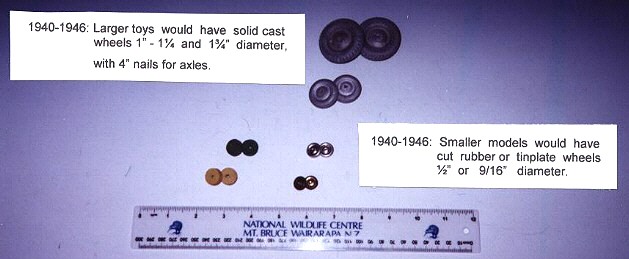Wheels in this range are useful as a guide to the age of the toy.
1940-1946: Smaller models would have cut rubber or tinplate wheels, 1/2 or 9/16" diameter.
1940-1946: Larger toys would have solid cast alloy wheels, 1" - 1-1/4" and 1-3/4" diameter, with 4" nails as axles.

1945-1950: Larger toys would have cast alloy wheels replaced by solid black moulded rubber wheels 3/4", 1", 1-1/4", and 1-3/4" diameter. Axles would still be nails till around 1950.

1951-1952: Plastic wheels of all sizes were introduced. Earliest ones were plain and coloured, and were possibly imported. However, wheels with "Fun Ho! - NZ" were soon the vogue, most having the diameter size embossed on one size.

1953-1954: A 2" diameter plastic hub was introduced with a removable 3-1/4: diameter removable tyre. This was first used on No. 505, 532, 534, 542 tractors, and later on the Giant series of trucks.
1955: This year saw a larger 3" diameter version of the plastic hub, designed to take a 4-3/4" diameter removable tyre. This was used with the larger tractors, Nos. 514, 516 and 519.
1956: A 3-5/8" diameter mudgrip tyre was added to the range, fitting the original 2" plastic hub and was used on Nos. 520, 521 and 531.

c.1958: during the late 1950s, a small 7/8" diameter plastic hub was introduced along with a 1-5/8" diameter removable rubber tyre. This was used as front wheels for tractors 505, 520, 521, 531; 528 bus; and 314 racer; as well as commercial vehicles Nos. 523, 524, 527, 529, 536, 416 and 417.
Many of the above models were later fitted with 1-3/4" diameter plastic wheels instead of "rubbers."

c.1966: A grey/black plastic blow-moulded wheel was used extensively, replacing the 3-1/4" diameter rubber tyred wheels. Latterly, this wheel had silver sections spray painted on one side.
1970s: Saw the rubber-tyred wheels diminish as cheaper plastic ones took their place. The first of these larger wheels was a dark grey blow-moulded, 3" diameter, purchased wheel.
c.1977: A shiny black plastic injection moulded wheel replaced the blow-moulded 3" diameter wheel on most tractors and Giant trucks in production at that time. It was produced by the Waihi Tool and Die Co. Ltd. and this name was embossed around the side of this wheel.

c.1975-1979: The new black plastic injection moulded 3" wheel was produced by Underwoods with "Fun Ho! NZ" embossed around the circumference. Wheel trims to fit between the six spokes were introduced within a few months, initially white, but finally yellow was the standard colour for all trims on 2", 2-1/4" and 1-3/4" diameter black or white Fun Ho! wheels. The range of wheels was used extensively on all Fun Ho! models till cessation of production at the end of 1982.
 Discs
Discs
1954: Plastic discs were also of white plastic and came in two sizes. Large ones for No. 513, which later became 508, and of course for No. 540. Smaller discs of a similar dished design were available for the discs in the No. 3 farm set.
1957: Plastic wheels were made for No. 525, large field roller. They were 1 1/2" diameter and continued unchanged until its demise in 1982.
 Special tractor wheels
Special tractor wheels
1940s: Tractor wheels for Nos. 78, 104b and 503 were specially cast. Spoked wheels of 2-1/2" diameter, along with 1-3/4", both with eight spokes and flat treads, were used as front and rear respectively for the tractors concerned. The smaller of these was also used for No. 439, large two furrow plough.
1964: Fun Ho! No. 545, Large Carryall, had four special 2-1/2" diameter cast wheels which were not used on any other model. The same year saw a 7 spoke wheel and tyre cast for the No. 151 Double Decker Bus and No. 420 Ford Sedan.
 Jumbo wheels
Jumbo wheels
1960s: McKenzie and Bannister had special wheels for their Jumbo tractor, which later became the main Fun Ho! tractor of the 1980s. Therefore as a few genuine Fun Ho!, No.s 801, 802 and 807, were fitted with their original Jumbo wheels, it is pertinent to give these details in this list. Hubs were of cast alloy, and with rubber tyres fitted, the wheels were 3" diameter overall. Front wheels were 1-1/4" solid rubber, similar to the early rubber wheels used by Fun Ho! after 1946.
 Axles
Axles
Early axles were sometimes crimped at the ends to prevent wheels slipping off, but for many years the solid plastic wheels were "press fitted."
Chrome plated or stainless steel fixing washers on the end of many toy axles gave an impression of hubcaps and were introduced around 1971-1972.
Transfers
Up to 1948-1949, gold backed Fun Ho! trade mark transfers were used, to be repalced by the same design on a bright yellow background.
The 1970s saw a general shift from transfers to self-adhesive stickers, though some transfers were used up to the 1980s.
- Barry Young